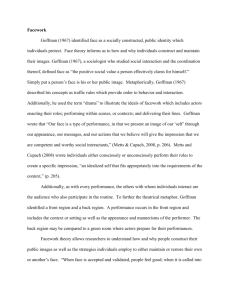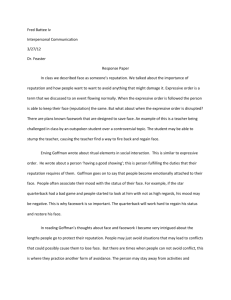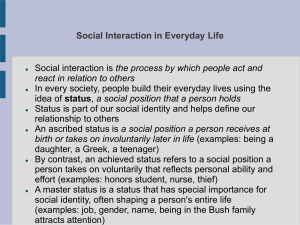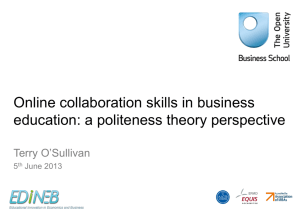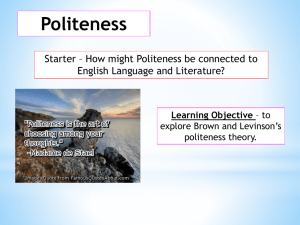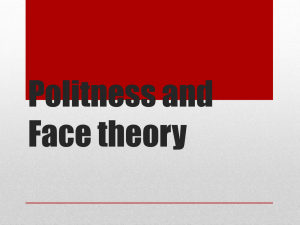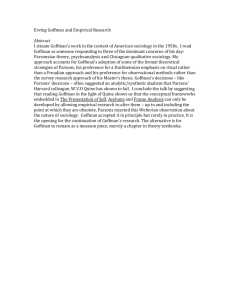Politeness for paper
advertisement
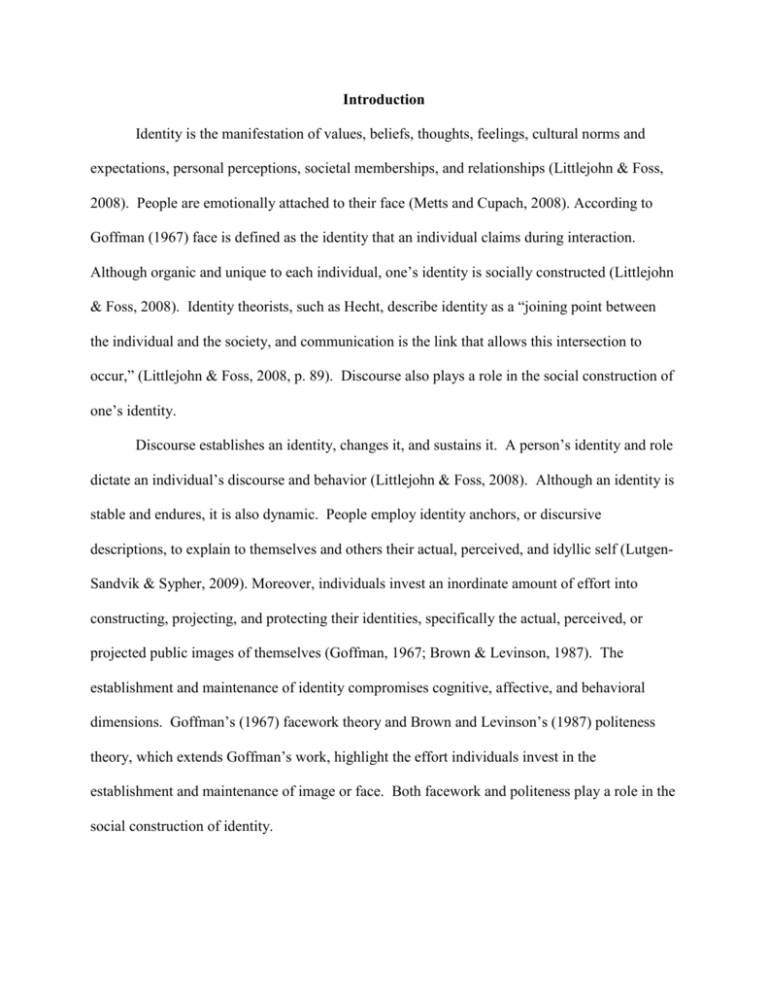
Introduction Identity is the manifestation of values, beliefs, thoughts, feelings, cultural norms and expectations, personal perceptions, societal memberships, and relationships (Littlejohn & Foss, 2008). People are emotionally attached to their face (Metts and Cupach, 2008). According to Goffman (1967) face is defined as the identity that an individual claims during interaction. Although organic and unique to each individual, one’s identity is socially constructed (Littlejohn & Foss, 2008). Identity theorists, such as Hecht, describe identity as a “joining point between the individual and the society, and communication is the link that allows this intersection to occur,” (Littlejohn & Foss, 2008, p. 89). Discourse also plays a role in the social construction of one’s identity. Discourse establishes an identity, changes it, and sustains it. A person’s identity and role dictate an individual’s discourse and behavior (Littlejohn & Foss, 2008). Although an identity is stable and endures, it is also dynamic. People employ identity anchors, or discursive descriptions, to explain to themselves and others their actual, perceived, and idyllic self (LutgenSandvik & Sypher, 2009). Moreover, individuals invest an inordinate amount of effort into constructing, projecting, and protecting their identities, specifically the actual, perceived, or projected public images of themselves (Goffman, 1967; Brown & Levinson, 1987). The establishment and maintenance of identity compromises cognitive, affective, and behavioral dimensions. Goffman’s (1967) facework theory and Brown and Levinson’s (1987) politeness theory, which extends Goffman’s work, highlight the effort individuals invest in the establishment and maintenance of image or face. Both facework and politeness play a role in the social construction of identity. Below, facework (Goffman, 1967) and politeness (Brown & Levinson, 1987) will be reviewed. Facework Goffman (1967) identified face as a socially constructed, public identity which individuals protect. Face theory informs as to how and why individuals construct and maintain their images. Goffman (1967), a sociologist who studied social interaction and the coordination thereof, defined face as “the positive social value a person effectively clams for himself.” Simply put a person’s face is his or her public image. Metaphorically, Goffman (1967) described his concepts as traffic rules which provide order to behavior and interaction. Additionally, he used the term “drama” to illustrate the ideals of facework which includes actors enacting their roles; performing within scenes, or contexts; and delivering their lines. Goffman wrote that “Our face is a type of performance, in that we present an image of our ‘self’ through our appearance, our messages, and our actions that we believe will give the impression that we are competent and worthy social interactants,” (Metts & Cupach, 2008, p. 206). Metts and Cupach (2008) wrote individuals either consciously or unconsciously perform their roles to create a specific impression, “an idealized self that fits appropriately into the requirements of the context,” (p. 205). Additionally, as with every performance, the others with whom individuals interact are the audience who also participate in the routine. To further the theatrical metaphor, Goffman identified a front region and a back region. A performance occurs in the front region and includes the context or setting as well as the appearance and mannerisms of the performer. The back region may be compared to a green room where actors prepare for their performances. Facework theory allows researchers to understand how and why people construct their public images as well as the strategies individuals employ to either maintain or restore their own or another’s face. “When face is accepted and validated, people feel good; when it is called into question, they feel bad. Thus, the general rules of ‘self-respect’ and ‘considerateness’ lead us to act in ways that maintain our own face and to cooperate in the maintenance of others,” (Metts & Cupach, 2008, p. 206). If a face threatening situation occurs interactants may lose face. Goffman identified two types of loosing face. The first in being in “wrong face”, the second is being “out of face.” An individual may be in wrong face when information is disclosed or behavior enacted that is incongruent with a person’s projected public image. Being out of face occurs when an individual cannot maintain an image that is either expected or required in a given situation. People engage in facework and communicate and behave in ways to either avoid face dissonance or restore their public image. Facework includes myriad strategies, including verbal and nonverbal messages. Excuses, justifications, remediation, humor, avoidance, and aggressive actions may be incorporated into face-saving methods as well (Metts and Cupach, 2008). Face is socially constructed; therefore, the strategy employed will be dictated by the context. These potential situations of face dissonance propel individuals to communicate and behave in ways that do not threaten their public image. However, if these situations do occur people engage in facework. Metts and Cupach (2008) referenced the work of Cavanagh, Dobash, Dobash, & Lewis (2001) who studied the remedial face-work of men who behaved violently toward their significant female others. Several of the strategies these perpetrators employed were denial, shifting blame, minimization, and reduced competence. Additionally some of the men apologies, cried, offered gifts, or vowed not to repeat the behavior. Brown and Levinson (1987) extended Goffman’s facework theory, positing that politeness is one way people protect and maintain their face as well as that of others. This concept will be further explicated below. Politeness Politeness can be used to predict patterns and interpretations of language use in specific contexts (Goldsmith, 2008). Additionally, politeness informs how and why messages are created and interpreted. Politeness creates an impression of the speaker, the hearer, the action and the relationship, according to Metts and Cupach (20098). “Effective communication entails choosing the right amount of politeness for the situation,” (Goldsmith, p. 260). Not employing enough politeness can be interpreted as being rude. Being too polite may compromise understanding of a person’s message or behavior. According to Goldsmith, Brown and Levinson (1987) face is defined as “the public self-image that every member wants to claim…” (p. 256). Their assumptions are congruent with Goffman, (1967) that face is desired, socially constructed; public; and claimed. Therefore, face can be lost, saved, or sustained during interactions. In the abstraction of Goffman’s original theory, Brown and Levinson identify both positive and negative face. Positive face centers around a person’s desire to be approved of and accepted by those with whom he or she is interacting. Negative face refers to an individual’s desire to be autonomous and free from restraint. Individuals find themselves in positions where their identity is challenged; this is referred to as a face threat. Specifically, face-threatening actions (FTA) are verbal or nonverbal communiqués or behaviors which potentially or actually compromise a person’s public image. According to politeness theory’s original scholars, five strategies are possible in the wake of FTAs. The first is “bald on record”, which allows an interactant to honestly act or react, without tact or diplomacy. Positive face redress, is the second politeness approach; it capitalizes on any existing relationship and commonalities between the interactants. Negative face redress employs respect to mitigate face threats. The fourth approach is referred to as between the lines in that it implies a verbal or nonverbal face-saving strategy. Finally, not making any statement in light of an FTA is the fifth approach. The strategy ultimately employed is dictated by the interactive context. This situational determinant is defined by three features: power, distance, and rank. Power relates to a relational hierarchy in which one can impose control or marginalization on another. Distance refers to the closeness and similarity of the interactants. Rank is culturally defined and refers to actual or perceived risk involved in enacting an FTA. The aggregate of these factors is known as the weight, or degree of face threat. A higher degree of threat elicits an more polite approach, whereas a situation which includes less weight prompts a less polite strategy. Application A person’s perceived or projected image will dictate his or her discursive behaviors regarding specific issues (Goffman, 1967; Brown & Levinson, 1987). At the core of facework and politeness theories are a person’s identity and the innate need and desire to be appreciated and honored. Individuals use language and situational and relational contexts to influence impressions; these employments are predicated on saving both an individual’s and interlocutor’s face. These discourse/interaction-centered theories of communication are applicable in the study of the muted male voice of the detached undergraduate relative to sexual assault issues. Facework and politeness theories can guide the examination of this phenomenon. These theoretical frameworks allow researchers to understand how and why people create certain messages and enact certain behaviors. Detached Muted Males Detached male undergraduates will most likely claim a particular face, which may be anchored in some degree of bravado and masculinity. Consistent with identity theorists, undergraduate males want to be respected, honored, appreciated, and respected. Further, muted males may deliberately enact behaviors and dialogue congruent with their perceived, actual, or projected images. Moreover, it is possible that detached men do not believe they have any significant insight regarding the overarching issue of sexual assault; that sexual assault is relevant; that they could be victims, whether actual or as part of a third-person effect; or that they have any frame of reference regarding sexual assault to manage their discourse and behaviors successfully (Doughtery, 2009). Perhaps detached muted males do see themselves as informed individuals who could extend education, prevention, and intervention efforts, but they do not want to engage in associated efforts because they want to avoid communicating or behaving in ways that could potentially jeopardized their actual or stereotypical identities. In this case, muted males most likely experience dialectical tension. They want to contribute in significant ways to informing the issue but are not cognizant of the most effective way to do so. Facework and politeness strategies can be used to explore disclosure and dialogic practices of detached males, specifically the nature of what is said about sexual assault and the manner in which it is said. Additionally, the strategy employed to mitigate face threats can directly or indirectly impact communication effectiveness (Goldsmith, 2008). Future Research In her essay regarding sexual harassment, Dougherty (2009) referenced the benefits of having change agents, which may include detached males who are not engaging in the relative dialogue. Establishing a safe dialogic environment that enrolls the detached muted male voice may be beneficial in creating realistic awareness of sexual assault among undergraduates. The context of exchanges involving detached muted males will be crucial as context is the environment in which discourse is situated. Further, context is constitutive, co-constructed and influenced by status and power (Fairhurst, 2001; Marx, 1967; Weber, 1978), and time, space, and location (Hopson, M., personal communication, January 19, 2010). The leadership of George Mason University Sexual Assault Services (SAS) may want to conduct focus groups which include male undergraduates to gain insight regarding how to efficiently and effectively develop programs for muted males so that they become confident, comfortable, and willing to work toward enhancing the effectiveness of sexual assault education, prevention, and intervention programs. The results of a relative study could include an interpretive, testimonial performance, much like The Vagina Monologues. Such a performance could privilege the detached muted male perspective by incorporating narratives which characterize structure, power, sociopolitical environment, hegemony, discourse typologies, codes, functions of language, meaning, context, rules, norms, similarities, roles, dialectics, stereotypes, bullying, emotional tyranny, incivility, metaphor, and cultures. Interpretive vignettes based in the critical perspective could be presented by males on behalf of males from myriad cultures and experiences to increase the understanding and awareness of the muted male perspective. Monologues and dialogues through storytelling can construct meanings and help the males the actors represent as well as audience members make sense of the experiences described (Gephart, 1992; Boje, 1991 as cited in Mumby, 2001) while at the same times providing muted males a mechanism that maintains the integrity of their face. Through myriad discourse typologies – including humor, sarcasm, or everyday talk – a complementary version of The Vagina Monologues situated from the muted-male perspective could be used to educate and raise awareness of this infrequently considered perspective. The performance could literally and figuratively extend Goffman’s dramaturgical metaphor. Additionally, the performance could feature and be enacted by male change agents: boyfriends, husbands, or significant others of survivors; law enforcement officials; medical professionals; counselors; gay, bisexual, or transgender individuals; and fathers, grandfathers, or uncles. Furthermore, providing a production situated in the detached male voice may increase attendance among male students; one evening performance of The Vagina Monologues included only a few male theater patrons. Further, as with The Vagina Monologues, the naming of the production would contribute to its overarching effectiveness; one recommendation is The Penis Perspective. This initiative would not only raise awareness but (hopefully) ultimately elicit productive and appropriate responses and activism among the members of the male population of the student body. On a college campus, attendance at a performance could be mandatory for COMM 100 and COMM 101 classes as well as graduate and undergraduate students majoring in theater, leadership, international relations, communication, and health-related disciplines. Additionally, it could provide a unique, dynamic alternative to mandatory sexual harassment training for faculty and staff. The motivation of the effort is multi-fold: to empower the detached mutedmale perspective and might expand the reach and increase education and understanding among multiple SAS target audiences. Conclusion Dougherty (2009) outlined consequences of sexual harassment and possible steps to take to raise awareness and ultimately prevent it. Based on the in-class discussion with Connie Kirkland, SAS director, (personal communication, February 1, 2010) sexual assaults involving men are under-reported and traditionally there are few men stakeholders involved in SAS. Dougherty suggested that involving males “may be part of the solution”. Creating a civil, harmonious environment that reinforces mutual respect and protects the identity, image, and public face of all parties will be instrumental to the success of sexual assault educational, prevention, and intervention initiatives which are inclusive of detached muted-male voices. The application of facework and politeness theories can inform SAS as to how to foster dialogue among males on campus so they will become motivated to become valuable allies in accomplishing the SAS education, prevention and intervention missions. References Braithwaite, D. O., & Baxter, L. A. (2008). Chapter 1: Introduction: Meta-theory and theory in interpersonal communication research. In D. O. Braithwaite, & L. A. Baxter (Eds.), Engaging theories in interpersonal communication (pp. 1-18). Thousand Oaks, CA: Sage. Brown, P., & Levinson, S. C. (1987). Politeness: Some universals in language usage. Cambridge, UK: Cambridge University Press. Deetz, S. (2001). Conceptual foundations. In F. M. Jablin, & L. L. Putnam (Eds.). The new handbook of organizational communication: Advances in theory, research, and methods (pp. 3-46). Thousand Oaks, CA: Sage. Dougherty, D. (2009). Sexual harassment as destructive organizational process. In P. LutgenSandvik, & B. D. Sypher (Eds.). Destructive organization communication: Processes, consequences, & constructive ways of organizing (pp. 203-225). New York, NY: Routledge. Ensler, E. (2009). The Vagina Monologues. Fairfax, VA: George Mason University. Fairhurst, G. (2001). Dualisms in leadership research. In F. M. Jablin, & L. L. Putnam (Eds.). The new handbook of organizational communication: Advances in theory, research, and methods (pp. 379-439). Thousand Oaks, CA: Sage. Goffman, E. (1967). Interaction ritual: Essays on face-to-face behavior. New York, NY: Random House. Goldsmith, D. J. (2008). Chapter 19: Politeness theory. In D. O. Braithwaite, & L. A. Baxter (Eds.), Engaging theories in interpersonal communication (pp. 255-268). Thousand Oaks, CA: Sage. Kisselburgh, L. G., & Dutta, M. J. (2009). The construction of civility in multicultural organizations. In P. Lutgen-Sandvik, & B. D. Sypher (Eds.). Destructive organization communication: Processes, consequences, & constructive ways of organizing (pp. 121142). New York, NY: Routledge. Littlejohn, S. W., & Foss, K. A. (2008). Theories of human communication. (9th ed.). Belmont, CA: The Thomson Corporation. Lutgen-Sandvik, P., Namie, G., & Namie, R. (2009). Workplace bullying: Causes, consequences, and corrections. In P. Lutgen-Sandvik, & B. D. Sypher (Eds.). Destructive organization communication: Processes, consequences, & constructive ways of organizing (pp. 2752). New York, NY: Routledge. Metts, S., & Cupach, W. R. (2008). Chapter 15: Face theory: Goffman’s dramatistic approach to interpersonal interaction. In D. O. Braithwaite, & L. A. Baxter (Eds.), Engaging theories in interpersonal communication (pp. 203-214). Thousand Oaks, CA: Sage. Mumby, D. K. (2001). Power and politics. In F. M. Jablin, & L. L. Putnam (Eds.). The new handbook of organizational communication: Advances in theory, research, and methods (pp. 585-623). Thousand Oaks, CA: Sage. Putnam, L. L., & Fairhurst, G. T. (2001). Discourse analysis in organizations: Issues and concerns. In F. M. Jablin, & L. L. Putnam (Eds.). The new handbook of organizational communication: Advances in theory, research, and methods (pp. 78-136). Thousand Oaks, CA: Sage. Ting-Toomey, S. (1994). The challenge of facework. Albany, NY: State University of New York Press. Williams, C.W., Brown, R.S., Lees-Haley, P. R., & Price, J. R. (1995). An attributional (causal dimensional) analysis of perceptions of sexual harassment. Journal of applied social psychology, 25(13), 1169-1183.
